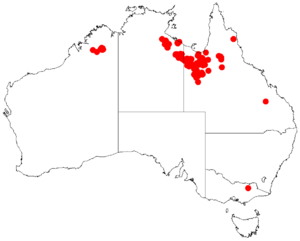Tabletop wattle facts for kids
Quick facts for kids Tabletop wattle |
|
|---|---|
| Scientific classification | |
| Genus: |
Acacia
|
| Species: |
phlebocarpa
|
 |
|
| Occurrence data from AVH | |
Acacia phlebocarpa, also known as tabletop wattle, is a type of shrub found in northern Australia. It belongs to a large group of plants called Acacia, which are well-known for their beautiful yellow flowers. This plant gets its common name, tabletop wattle, from its unique flat-topped shape.
What Does Tabletop Wattle Look Like?
The tabletop wattle is a shrub that spreads out and can grow from about 0.4 metres (1 ft) to 1.2 metres (4 ft) tall. It has a special flat top, like a table.
Its branches are sticky and smooth, or sometimes have tiny, flat hairs. They also have small, lasting parts called stipules, which are about 1 to 1.5 mm (0.039 to 0.059 in) long.
Like most Acacia plants, the tabletop wattle has phyllodes instead of true leaves. Phyllodes are flattened leaf stems that act like leaves. These phyllodes are straight and shaped like a narrow oval. They are about 2 to 5.5 cm (0.79 to 2.17 in) long and 4 to 12 mm (0.16 to 0.47 in) wide. They feel a bit like thin leather and have three main raised lines, plus many smaller lines running next to them.
This wattle blooms from April to June, showing off bright yellow flowers. Its flowers grow in round shapes, like small balls, about 7 to 8 mm (0.28 to 0.31 in) across. Each flower ball has 45 to 60 golden flowers.
After the flowers, long, thin seed pods grow. These pods are very curved or even form a single coil. They can be up to 6 cm (2.4 in) long and 4 to 6 mm (0.16 to 0.24 in) wide. Inside these pods are shiny black seeds, which are shaped like wide ovals or almost perfect circles. Each seed is about 3.8 to 4.3 mm (0.15 to 0.17 in) long.
Where Does Tabletop Wattle Grow?
The tabletop wattle is found in northern Australia. You can see it in the Kimberley area of Western Australia, as well as in northwestern Queensland and the Northern Territory.
It likes to grow in rocky places. You'll often find it on stony soils, especially those with a reddish rock called laterite. It also grows on sandstone on flat plains and rocky ridges. The soil in these areas is often shallow, stony, and sandy.
This plant usually grows in open woodlands or alongside other plants like Triodia, which are a type of grass.

